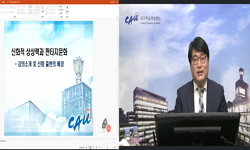본 논문의 목적은 플라톤의 대화편 『고르기아스』의 종반부에서 나타나는 사후 세계 신화의 의의를 재조명하는 것이다. 수사술·정치술·훌륭한 삶에 관한 등장인물 간의 치열한 논박이 �...
http://chineseinput.net/에서 pinyin(병음)방식으로 중국어를 변환할 수 있습니다.
변환된 중국어를 복사하여 사용하시면 됩니다.
- 中文 을 입력하시려면 zhongwen을 입력하시고 space를누르시면됩니다.
- 北京 을 입력하시려면 beijing을 입력하시고 space를 누르시면 됩니다.
https://www.riss.kr/link?id=T14797805
- 저자
-
발행사항
서울 : 서울시립대, 2018
-
학위논문사항
학위논문(석사) -- 서울시립대 일반대학원 , 철학과 , 2018. 2
-
발행연도
2018
-
작성언어
한국어
- 주제어
-
KDC
100 판사항(6)
-
발행국(도시)
서울
-
기타서명
The aterlife myth in Plato’s Gorgias and its significance
-
형태사항
i, 75 p. : 삽화, 도표 ; 26 cm.
-
일반주기명
참고문헌: p.71-73
- 소장기관
-
0
상세조회 -
0
다운로드
부가정보
국문 초록 (Abstract)
본 논문에서는 『고르기아스』에서의 사후 세계 신화가 단순한 허구의 이야기 혹은 종교적 믿음의 표현에 그치는 것이 아니라, 플라톤이 대화상대자·독자를 좋은 삶으로 이끌기 위한 실천적 목적에서 고안해낸 유용한 시적 장치(poetic device)임을 주장하고자 한다. 등장인물 소크라테스의 입을 빌려 청자들에게 전달되는 플라톤의 신화가 어떤 점에서 당대 아테네의 현실에 대한 철저한 반성의 결과물이며, 어떻게 소피스트·시인들의 이야기와는 구분되는 철학자의 이야기로서의 의미를 가지는 지를 밝히는 것이 본 논문의 주요 목표이다. 이를 위해 본 논문에서는 시적 장치로서의 『고르기아스』의 사후 세계 신화 해석에 도움을 줄 수 있는 Collobert의 플라톤 신화 논의 틀을 차용하면서, 또한 부분적으로는 플라톤 당대의 역사적 맥락에 대한 검토를 수행하며 『고르기아스』 대화편에 접근한다. 한편으로 본 논문에서는 『고르기아스』 대화편에서 파편적으로 나타나는 호메로스에 관한 언급들에도 주목하여, 사후 세계 신화뿐만 아니라 『고르기아스』 대화편에 대한 또 다른 해석을 가능하게 해 줄 플라톤과 호메로스 간의 연관성에 관한 실마리를 제시해본다. 이 모든 과정은 플라톤의 철학에서 신화가 우발적이거나 예외적인 요소가 아님을 보임과 동시에, 『고르기아스』 대화편에 대한 풍성한 독법을 제시하는 데 기여한다.
본 논문의 목적은 플라톤의 대화편 『고르기아스』의 종반부에서 나타나는 사후 세계 신화의 의의를 재조명하는 것이다. 수사술·정치술·훌륭한 삶에 관한 등장인물 간의 치열한 논박이 주를 이루는 이 대화편의 종반부(523a-527a)에서, 등장인물 소크라테스는 자신의 의견에 쉽사리 설득되지 않는 대화 상대자 칼리클레스를 향해 사후 세계에서 벌어지는 심판에 관한 신화 이야기를 전달한다. 외관상 비합리적인 종교적 믿음의 표명처럼 보이는 이 신화는, 대화편의 전체 내용과 플라톤의 철학과는 동떨어져 있는 것처럼 여겨진다는 점에서 많은 연구의 대상이 되어왔다.
본 논문에서는 『고르기아스』에서의 사후 세계 신화가 단순한 허구의 이야기 혹은 종교적 믿음의 표현에 그치는 것이 아니라, 플라톤이 대화상대자·독자를 좋은 삶으로 이끌기 위한 실천적 목적에서 고안해낸 유용한 시적 장치(poetic device)임을 주장하고자 한다. 등장인물 소크라테스의 입을 빌려 청자들에게 전달되는 플라톤의 신화가 어떤 점에서 당대 아테네의 현실에 대한 철저한 반성의 결과물이며, 어떻게 소피스트·시인들의 이야기와는 구분되는 철학자의 이야기로서의 의미를 가지는 지를 밝히는 것이 본 논문의 주요 목표이다. 이를 위해 본 논문에서는 시적 장치로서의 『고르기아스』의 사후 세계 신화 해석에 도움을 줄 수 있는 Collobert의 플라톤 신화 논의 틀을 차용하면서, 또한 부분적으로는 플라톤 당대의 역사적 맥락에 대한 검토를 수행하며 『고르기아스』 대화편에 접근한다. 한편으로 본 논문에서는 『고르기아스』 대화편에서 파편적으로 나타나는 호메로스에 관한 언급들에도 주목하여, 사후 세계 신화뿐만 아니라 『고르기아스』 대화편에 대한 또 다른 해석을 가능하게 해 줄 플라톤과 호메로스 간의 연관성에 관한 실마리를 제시해본다. 이 모든 과정은 플라톤의 철학에서 신화가 우발적이거나 예외적인 요소가 아님을 보임과 동시에, 『고르기아스』 대화편에 대한 풍성한 독법을 제시하는 데 기여한다.
다국어 초록 (Multilingual Abstract)
Asserting that Plato inserted this myth intentionally for the practical purpose of guiding the interlocutor and the expected readers of the dialogue into the good life, I claim that the afterlife myth in Gorgias can be interpreted as an informative poetic device rather than a mere fable or an expression of religious belief. Accordingly, the primary purpose of this paper is to reveal that the myth in Gorgias was an outcome Plato devised in order for him to display the political crisis of Athens in his time, and that how the story of the philosopher can have a significant meaning distinguished from that of sophists and poets. For this purpose, I firstly adopt the scheme of C. Collobert, which is helpful to interpreting Plato’s myths as a poetic device. And, I partly conduct a research concerning the historical background of those who lived in Athens at Plato’s time, thereby finding a useful approach to interpreting Gorgias. Paying attention to several allusions to Homer which appears in Gorgias, lastly, I provide a clue, according to which Plato and Homer are significantly related. Hence, the clue helps understand the myth of afterlife in Gorgias clearly, suggesting another interpretation of the dialogue. Thus, this whole inquiry show that the myth in Gorgias is not a superfluous adjunct in Plato’s philosophy, providing another fruitful way of reading the dialogue.
This paper aims to reveal the significance of the afterlife myth which appears at the last part of Plato’s Gorgias. After the main characters discuss the nature of rhetoric, politics, and the good life in this dialogue, Socrates finally introduces a...
This paper aims to reveal the significance of the afterlife myth which appears at the last part of Plato’s Gorgias. After the main characters discuss the nature of rhetoric, politics, and the good life in this dialogue, Socrates finally introduces a story regarding the judgment of souls in the afterlife to Callicles, whom he failed to convince through the arguments. Because the afterlife myth in Gorgias seems to be an expression of irrational and religious belief of Socrates in a sense, quite a lot of scholars considered this myth incongruous with the rest of the dialogue and even with the philosophy of Plato, attempting to conduct research on this issue.
Asserting that Plato inserted this myth intentionally for the practical purpose of guiding the interlocutor and the expected readers of the dialogue into the good life, I claim that the afterlife myth in Gorgias can be interpreted as an informative poetic device rather than a mere fable or an expression of religious belief. Accordingly, the primary purpose of this paper is to reveal that the myth in Gorgias was an outcome Plato devised in order for him to display the political crisis of Athens in his time, and that how the story of the philosopher can have a significant meaning distinguished from that of sophists and poets. For this purpose, I firstly adopt the scheme of C. Collobert, which is helpful to interpreting Plato’s myths as a poetic device. And, I partly conduct a research concerning the historical background of those who lived in Athens at Plato’s time, thereby finding a useful approach to interpreting Gorgias. Paying attention to several allusions to Homer which appears in Gorgias, lastly, I provide a clue, according to which Plato and Homer are significantly related. Hence, the clue helps understand the myth of afterlife in Gorgias clearly, suggesting another interpretation of the dialogue. Thus, this whole inquiry show that the myth in Gorgias is not a superfluous adjunct in Plato’s philosophy, providing another fruitful way of reading the dialogue.
목차 (Table of Contents)
- 서론 - 1
- 제1장 ‘앎에 기반한 모상’으로서의 철학자의 신화 - 9
- 제1절 유사 닮음(phantasma)과 이미지의 본성 - 10
- 제2절 소피스트·시인들의 언어-이미지 vs. 철학자의 언어-이미지 - 15
- 제2장 『고르기아스』 대화편 분석 - 24
- 서론 - 1
- 제1장 ‘앎에 기반한 모상’으로서의 철학자의 신화 - 9
- 제1절 유사 닮음(phantasma)과 이미지의 본성 - 10
- 제2절 소피스트·시인들의 언어-이미지 vs. 철학자의 언어-이미지 - 15
- 제2장 『고르기아스』 대화편 분석 - 24
- 제1절 고르기아스와 폴로스의 수사술 – 소피스트들의 언어-이미지 - 25
- 제2절 칼리클레스와 소크라테스 – 신화 도입의 맥락 - 39
- 제3장 『고르기아스』 신화의 의의 - 50
- 제1절 『고르기아스』의 사후 세계 신화 - 51
- 제2절 철학자의 신화와 호메로스적 요소 - 63
- 결론 - 70
- 참고문헌 - 71
- abstract - 74












